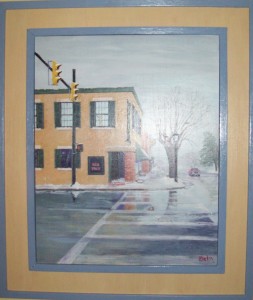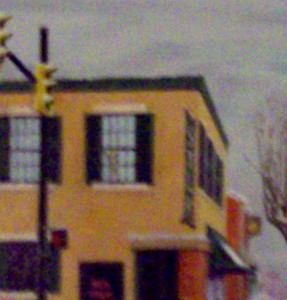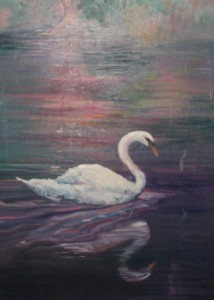
In Richard Burton’s painting, The Red Truck, the slushy melting snow on the road and the reflections seen in the puddles are the “icing on the cake.”
To add a further dimension to your painting,include any reflections that should be seen in your composition. Tip: When doing this, remember that the angle of the reflected image to the reflected surface will be the same as the object itself. It is important when painting or drawing that you realize that the distance from any point on the image to the reflective surface is the same as the distance from the same point in the reflection to the reflective surface.
Keep in mind, when you are out sketching, there are many things that can create reflective surfaces; such as, water surfaces, windows in buildings, or any shiny surface (example: mirrors, hubcaps, or boat railings, etc.).

Although the segment of The Red Truck painting is a bit blurry because of the enlargement, you can clearly see the inclusion of the reflection of the street light in the window was important to the painting.
There are different types of reflections that must be considered (at least, for the realist artist). One that is very important is caustic reflections. The best way to describe this is to experiment with it. In a morning sun, lay a piece of white paper on a sundeck or patio table. With four clear different shaped glasses fill them a few inches with water. Place them in a row with the sun shining directly through them and study the reflections in the shadows.
*Caustics are the spots, arcs, or wavy bands of light projected onto a surface by means of refraction or reflection from a curved glass or from waves on water. TIP:When painting scenes with water, these caustic reflections of light become important especially when the light reflects off the side of a boat or other solid object.
*Specular reflection: Light rays bounce off of the surface of an object at the same angle as they approach it.
*Diffuse reflection: Light rays bounce in all directions.

In Lynn Burton’s painting Swan Lake Reflections, the realistic painting of the goose is surrounded by an abstract background of seemingly moving colors. The waves the floating fowl makes liven the movement and the reflection on the water.
Be sure to join us by signing up for our newsletter. Your name will be entered into our next give away drawing for a beautiful volume of Splash 14.
Also, check out our art galleries at the top of the page.
There are some great opportunities available for artist at the top of the page, as well. Check them out.
Feel free to make a comment at the bottom of the page (No spam please.).
*Research information from this particular segment of the post was taken from Color and Light: A guide for the Realist Painter by James Gurney. (We highly recommend this book for any professional artist as well as the wannabe artist.)
